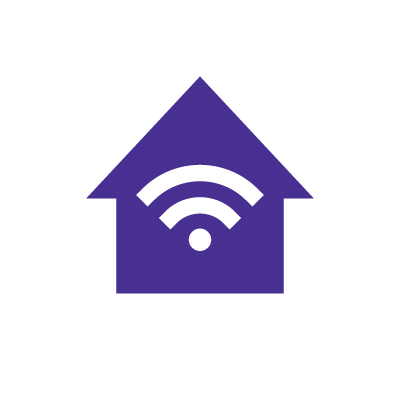What is WiFi 7? (The latest WiFi standard)

Since the release of WiFi in 1997, referred to as IEEE 802.11, the Institute of Electrical and Electronics Engineers (IEEE) has been setting the standards for WiFi and all of its future iterations.
Released in early 2024, WiFi 7 is the latest WiFi standard, succeeding WiFi 6 and WiFi 6e.
For over 19.5 billion devices in use, WiFi 7 may soon become the current standard for all users. In this article, we’ll discuss the history, the speed and the current state of WiFi 7.
What you'll learn:
- What is WiFi 7?
- When is WiFi 7 coming out?
- What are the advantages of WiFi 7?
- WiFi 7 technical specifications
- WiFi generations chart
- New features with WiFi 7
- How fast is WiFi 7?
- Do I need a WiFi 7 router?
- The future of WiFi technology
- Bottomline: Is WiFi 7 worth it?
- Frequently asked questions
- Looking for more topics?
WiFi that just works!
WiFi plans for any home
Tiny, large or somewhere in between; find WiFi coverage to fit any space. Blanket your entire home with a fast and ultra‑reliable connection.

What is WiFi 7?
WiFi 7 is the latest WiFi standard, established by the Wi-Fi Alliance on January 8, 2024. It offers significantly improved support for a greater number of simultaneous low-latency connections in congested environments streaming ultra-high-definition video to multiple devices.
WiFi 7 introduces 320 MHz channels and 4K QAM, doubling the channel width of previous standards and packing more data into each transmission. Additionally, more devices can connect simultaneously on multiple bands, reducing interference in crowded networks.
For home internet users, WiFi 7 means faster and more reliable performance, perfect for high-bandwidth applications like streaming 8K videos, immersive gaming and supporting a large network of connected smart home devices.
As WiFi 7 is the latest standard, routers and Internet Service Providers (ISPs) will need time to develop compatible hardware and software to operate effectively with WiFi 7.
When is WiFi 7 coming out?
WiFi 7 is already here and ready for early-adopters. TP-Link has released a line of WiFi 7-enabled routers starting at $600. Currently, these products are on store shelves, but they are largely marketed to hardware enthusiasts. Most devices in homes and available for sale today aren’t WiFi 7-compatible so consumers cannot reap the benefits of this latest technology.
Moreover, although the WiFi 7 standards may be developed, many enterprises are still catching up with the rapid pace of Wi-Fi development. Research shows 41% of the respondents in the WBA Annual Industry Report 2024 plan to deploy “WiFi 6 or WiFi 6e as their next wireless investment.’
However, we will see affordable consumer WiFi 7-enabled hardware, as companies like Microsoft, Intel, Apple and other giants build WiFi 7 capabilities into their products and encourage mass adoption. Expect to see more phones, laptops, smart devices and routers supporting WiFi 7 in the near future.
Switch & save
Astound is the #1 cable ISP
Stream live content, work, surf, game and connect to multiple devices with speeds up to 1500* Mbps through our ultra‑reliable fiber‑powered network.*

What are the advantages of WiFi 7?
WiFi 7’s specific advancements make it well-suited for modern digital life and both new and developing technology. Here are some of the specific advantages of WiFi 7 compared to previous generations.
Increased Channel Width
WiFi 7 supports channel widths up to 320 MHz, double WiFi 6’s 160 MHz.
Advanced Modulation
WiFi 7’s advanced QAM modulation improves data encoding, increasing throughput by 20% compared to Wi-Fi 6/6e.
Multi-Link Operation (MLO)
WiFi 7 enables simultaneous data transmission over multiple frequency bands, like 2.4 GHz, 5 GHz and 6 GHz.
Altogether, the combination of larger channel width, advanced modulation and MLO improve data transmission. This enables applications that demand high throughput and low latency, such as immersive 3D training, HD and 4K video streaming, massive online multiplayer gaming and large-scale virtual and in-person events.
WiFi 7 technical specifications
Over previous generations of WiFi – namely WiFi 6e, WiFi 6, and WiFi 5 – WiFi 7 is more powerful overall. Let’s take a closer look at some of WiFi 7’s technical specifications.
Increased Speeds
WiFi 7 offers speeds up to 46 Gbps, compared to 9.6 Gbps in WiFi 6 and 6e, and 3.5 Gbps in WiFi 5.
Frequency Band Range
WiFi 7 can use different frequency bands (2.4 GHz, 5 GHz, and 6 GHz) simultaneously, compared to previous generations like WiFi 5, which only could only use a single frequency band.
Wider Channel Bandwidth
WiFi 7 supports channels up to 320 MHz wide, doubling the 160 MHz max of WiFi 6 and 6e. WiFi 6 and WiFi 6e introduced 160 MHz channels, which were a step up from the 80 MHz maximum of WiFi 5.
QAM Modulation
WiFi 7’s 4096-QAM (Quadrature Amplitude Modulation) improves pre-existing QAM technology used in WiFi 6 and 6e, packing more data into each transmission and boosting speeds.
Enhanced MIMO Capabilities
WiFi 7’s enhanced MIMO capabilities (16 spatial streams) can handle more simultaneous connections and higher aggregate data rates. WiFi 6 and WiFi 6e support up to 8×8 MU-MIMO (8 spatial streams), which was an improvement over the 4×4 MIMO configurations of WiFi 5.
WiFi generations
| Comparisons | WiFi 5 | WiFi 6 | WiFi 6e | WiFi 7 |
|---|---|---|---|---|
| Launch date | 2013 | 2019 | 2021 | 2024 |
| IEEE standard | 802.11ac | 802.11ax | 802.11ax | 802.11be |
| Max data rate | 3.5 Gbps | 9.6 Gbps | 9.6 Gbps | 46 Gbps |
| Bands | 5GHz | 2.4, 5GHz | 6GHz | 2.4, 5, 6GHz |
| Channel size | 20, 40MHz | 20, 40, 80, 80+80, 160 MHz | 20, 40, 80, 80+80, 160 MHz | Up to 320MHz |
| Modulation | 256 QAM | 1024 QAM | 1024 QAM | 4096 QAM |
| MIMO | 4x4 MIMO, DL MU-MIMO | 8x8 MIMO, UL/DL MU-MIMO | 8x8 MIMO, UL/DL MU-MIMO | 16x16 MIMO, UL/DL MU-MIMO |
|
Comparisons
Launch date |
WiFi 5
2013 |
WiFi 6
2019 |
WiFi 6e
2021 |
WiFi 7
2024 |
|
Comparisons
IEEE standard |
WiFi 5
802.11ac |
WiFi 6
802.11ax |
WiFi 6e
802.11ax |
WiFi 7
802.11be |
|
Comparisons
Max data rate |
WiFi 5
3.5 Gbps |
WiFi 6
9.6 Gbps |
WiFi 6e
9.6 Gbps |
WiFi 7
46 Gbps |
|
Comparisons
Bands |
WiFi 5
5GHz |
WiFi 6
2.4, 5GHz |
WiFi 6e
6GHz |
WiFi 7
2.4, 5, 6GHz |
|
Comparisons
Channel size |
WiFi 5
20, 40MHz |
WiFi 6
20, 40, 80, 80+80, 160 MHz |
WiFi 6e
20, 40, 80, 80+80, 160 MHz |
WiFi 7
Up to 320MHz |
|
Comparisons
Modulation |
WiFi 5
256 QAM |
WiFi 6
1024 QAM |
WiFi 6e
1024 QAM |
WiFi 7
4096 QAM |
|
Comparisons
MIMO |
WiFi 5
4x4 MIMO, DL MU-MIMO |
WiFi 6
8x8 MIMO, UL/DL MU-MIMO |
WiFi 6e
8x8 MIMO, UL/DL MU-MIMO |
WiFi 7
16x16 MIMO, UL/DL MU-MIMO |
Build your plan
Your perfect plan is just a click away
Get the speeds, WiFi, mobile and TV plans you need all at an affordable price. Bundle your services with Astound and see how much you can save.

New features with WiFi 7
WiFi 7 brings new features to enhance wireless network performance, efficiency, and reliability, setting it even further apart from previous WiFi standards.
Let’s take a closer look at some of the features.
Multi-Link Operation (MLO)
MLO allows devices to simultaneously send and receive data across different frequency bands (2.4 GHz, 5 GHz, 6 GHz) and switch between them, improving throughput, reducing latency and enhancing reliability.
Multi-RU
With WiFi 7, a single user can leverage multiple Resource Units (RUs), depending on their needs. By using multiple RUs, a user can more precisely manage their bandwidth allocation, giving just enough resources to a specific device based on its requirements.

Power-saving WiFi Operation
WiFi 7 also includes cross-wake-up signaling to assist in power-saving, which allows devices to monitor links, even in idle mode, and use power more efficiently.
Preamble Puncturing
This feature enables WiFi transmission to maximize its use of the spectrum by avoiding highly congested channels, or subchannels with interference. Preamble puncturing maintains high transmission speeds and quality in environments with significant interference.
How fast is WiFi 7?
WiFi 7 is the fastest WiFi standard yet.
Theoretically, WiFi 7 enables devices to transmit data over the 2.4, 5, and 6GHz wireless frequency bands at speeds of up to 46 Gbps. However, devices available to the general public are limited by the physical layer (PHY) specifications, which are the standard for modulating and receiving transmissions of WiFi.
In an ideal setting, WiFi 7 can reach speeds of about 4.8 Gbps. Early adopters of WiFi 7 have taken to Reddit, showing their speed tests reaching 3.8 Gbps in real time.
However, these speeds are dependent on many factors, such as channel configuration, spectrum and range. Your actual speed experience may vary due to network congestion, device performance and the quality of your WiFi connection.

Mesh WiFi with
eero Secure
Enhanced Whole Home WiFi uses multiple routers (or eeros®) to boost range, speed, and stability, while eero Secure, included at no extra cost, offers parental controls, ad blocking, and internet backup for constant connectivity.
Do I need a WiFi 7 router?
Yes, you will need a WiFi 7 router In order to achieve speeds beyond a Gigabit, increased bandwidth and the enhanced features of WiFi 7.
WiFi 7 will be backward compatible with older WiFi standards like WiFi 6e. However, to achieve the speeds that WiFi 7 offers, both transmitting/receiving devices must support WiFi 7, meaning that not only your router and modem must be WiFi 7 enabled but also your phones, computers or tablets.
However, no matter your WiFi standard, all home networks can benefit from a mesh WiFi system. These systems, like eero, create a mesh network that enables multiple WiFi routers to work together, bringing improved range, speed and stability into your home.
Whether it’s an apartment, a townhome or a single family home, enhanced Whole Home WiFi is easy to install and works no matter the shape or size of your home.

eero Plus
eero Plus protects your family online with a password manager to safely create, store and share passwords, virus and malware protection and a VPN that lets you browse the web safely and securely.
The future of WiFi technology
WiFi technology is constantly evolving and the IEEE is already planning for future developments of WiFi 8. Known as 802.11bn, WiFi 8 aims to enhance multi-access point (AP) coordination and build upon the multi-link operations introduced in WiFi 7.
Though WiFi as a technology is reaching incredible levels of speed, WiFi 8 will also focus on Ultra High Reliability (UHR), which is crucial for technologies that rely on consistent and dependable wireless communication like robotic-assisted surgeries or autonomous vehicles.
While WiFi 7 significantly increased data rates, WiFi 8 is set to revolutionize the stability and efficiency of wireless connections.
Bottomline: Is WiFi 7 worth it?
Compared to older WiFi standards, WiFi 7 offers the best speed and connectivity developed yet. However, WiFi 7 hardware and software are still in development and adoption of the technology may take some time.
For homes with many users, devices and connected IoT gadgets, WiFi 7 will provide the fastest speed possible.
Because of WiFi 7’s Gigabit speeds, simultaneous 4K video streams, online gaming, large file downloads, data transfers, remote work and school all become effortless tasks. With the right ISP, hardware configuration and software access, WiFi 7 is certainly worth it.
However, to be an early adopter of WiFi 7, you will have to pay a high price to reap the rewards. At the moment, the technology is for WiFi enthusiasts or the curious few who want to own the newest WiFi networking systems.
If you’re on an older generation of WiFi and you experience a surge in users and devices, want to expand your network or access Gig+ speeds, consider upgrading to WiFi 6. It’s an established, affordable solution that will improve your home WiFi network overall.
No matter your WiFi version or set up, understand your internet needs first and choose the right ISP.
Frequently asked questions
What is the current WiFi standard?
On January 8, 2024, the Wi-Fi Alliance introduced the Wi-Fi CERTIFIED 7 program. As such, the current WiFi standard is WiFi 7.
What’s the difference between WiFi 7, WiFi 6e, WiFi 6, and WiFi 5?
WiFi 7 outperforms previous generations by offering speeds up to 46 Gbps, double the channel width of WiFi 6 and 6e (up to 320MHz), and introduces Multi-Link Operation for more efficient bandwidth use, making it faster and more reliable than WiFi 6e, WiFi 6 and WiFi 5.
Is WiFi 7 secure?
WiFi 7 is the most secure WiFi standard produced thus far. WiFi 7 supports WPA4, the latest in WiFi security, enhancing network protection overall. However, the security of your home WiFi network depends on your ability to prevent users with malicious intent from accessing your network and devices.
*Internet speeds may vary & are not guaranteed. Certain equipment may be required to reach advertised speeds. DOCSIS 3.1 modem with 2.5GE physical LAN port is required for 1 Gigabit speeds and higher. See astound.com/yourspeed for why speeds may vary. To view Astound’s FCC Network Management Disclosure see astound.com/policies-disclaimers. Limited time offer, subject to change without notice. Advertised promotional price valid for duration of the stated promotional period from time of service activation. Regular rates apply after promotional period ends. Equipment not included and is extra. Modem required for Internet service. Enhanced Wi-Fi or Whole Home Wi-Fi (eero) not included and is add’l. Offer includes a monthly discount for enrollment in both automatic payments (autopay) & paperless billing (e-bill). Discount of $10 applies with automated bank account deduction or a discount of $5 applies with automated credit/debit card payment. Valid email address required. Must complete enrollment in autopay and e-bill within 30-days of placing the order. Without enrollment, the discount does not apply. Discount appears on bill within 3 bill cycles after enrolling. If either autopay or e-bill is canceled, services are changed, or the account is not in good standing, then the monthly discount will be discontinued. Offer valid only for new residential Astound customers or previous customers with an account in good standing who have not had Astound service within the last 60 days. Any add’l services, equipment, premium channels & other tiers of service are subject to an add’l charge & regular increases. A one-time activation fee of $14.99 (in addition to any installation fees) will be charged & is subject to change. Add’l fees apply for taxes & surcharges, and are subject to change. WA RESIDENTS: unless otherwise specified, price does not include a 2% Regulatory Administration Fee. For details about taxes, fees & surcharges visit astound.com/fees. No early termination fees apply in the event service is terminated in advance of the promotional end date. Customer is responsible for any accrued service charges in the event service is canceled. Subject to credit check. Not all services & speeds are available in all areas. A multi-product discount may be available to qualifying addresses with a subscription to mobile, TV, and 600 Mbps Internet or higher. Discounts will be reflected in your order cart at time of purchase, if available. Other restrictions may apply. All services are governed by the Astound Customer Terms & Conditions that can be found at astound.com/policies-disclaimers. © 2025 Radiate HoldCo, LLC d/b/a Astound Broadband. All rights reserved.
While we have made every attempt to ensure that the information contained in this site has been obtained from reliable sources, Astound is not responsible for any errors or omissions, or for the results obtained from the use of this information. All information in this site is provided “as is”, with no guarantee of completeness, accuracy, timeliness and without warranty of any kind, express or implied, including, but not limited to warranties of performance, merchantability and fitness for a particular purpose. Certain links in this site connect to other websites maintained by third parties over whom Astound has no control. Astound makes no representations as to the accuracy or any other aspect of information contained in other websites.
eero Plus is available for an additional $9.99/month and requires subscription to whole home WiFi powered by eero.


















